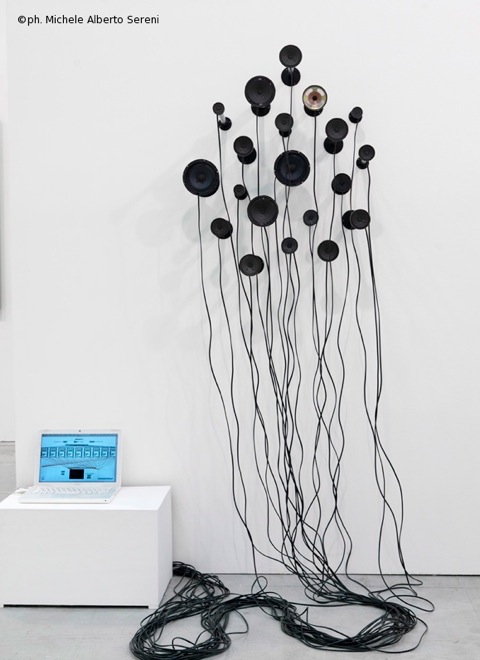Roberto Pugliese – Soniche Vibrazioni Computazionali
A cura di Valentina Tanni
SCARICA COMUNICATO STAMPA (ITA)
DOWNLOAD PRESS RELEASE (ENG)
SCARICA TESTO CRITICO (ITA)
Inaugurazione sabato 19 marzo 2011 ore 11.30
Fino al 26 aprile 2011
Studio La Città, Lungadige Galtarossa, 21 – 37133 Verona, Italy
www.studiolacitta.it
www.robertopugliese.com

[ENGLISH VERSION BELOW]
Siamo abituati a vedere la tecnologia come il mezzo per raggiungere un fine. Tuttavia, se da un lato la consideriamo un semplice dispositivo per risolvere problemi, allo stesso tempo la carichiamo di simbologie, aspettative e paure. Ma mentre eravamo impegnati a cercare di definirla, è successo qualcosa che ha cambiato le carte in tavola, modificando per sempre lo scenario: tecnologie ed esseri umani sono diventati intimi. Con l’avvento dei personal computer, e poi con la miniaturizzazione dei circuiti elettronici – per non parlare di protesi e biotecnologie – abbiamo avuto la possibilità di confrontarci con le macchine a un livello diretto ed empatico: sono entrate a far parte della nostra vita quotidiana, modificando i pensieri, i gesti, le abitudini, mediando i rapporti interpersonali.
Questa mutazione, passata a lungo inosservata, è invece fondamentale per comprendere quanto sia problematico oggi definire un confine tra naturale e artificiale; quanto i nostri corpi e le nostre menti siano inestricabilmente legati al linguaggio digitale, filtro concettuale e principio guida della contemporanea visione del mondo. L’arte elettronica – per usare un’etichetta poco precisa ma utile a definire il contesto – è stata fondamentale per analizzare e raccontare queste complesse relazioni: tra analogico e digitale, organico e inorganico, naturale e tecnologico.
Nel caso delle opere di Roberto Pugliese, la macchina – e più nello specifico, il software diventa un dispositivo al servizio della vita. Un sistema per “catturare” le energie della natura e canalizzarle all’interno dell’opera d’arte, che diventa così un oggetto vivo, mutevole, imprevedibile. Ma lungi dallo smaterializzarsi, un processo che spesso attiene all’arte tecnologica, l’opera manifesta prepotentemente la sua fisicità ed esprime una qualità scultorea, quando non addirittura monumentale.
ENGLISH VERSION
We are used to considering technology as a means to an end. However, if on the one hand we consider it simply as a devise for
resolving problems, on the other we imbue it with symbolism, expectations, and fear. But while we were busy trying to define it, something happened that moved the goal posts and permanently changed the scenario: technology and human beings became intimate. With the arrival of personal computers and then with the miniaturization of electric circuits – not to mention prostheses and biotechnology – we have had the opportunity of dealing with machines at a direct and empathetic level: they have become part of our everyday life changing thoughts, gestures, and habits by mediating personal relationships. This change, which went unnoticed for a long time, is instead fundamental for understanding just how problematic it is today to define a boundary between natural and artificial, so much have our body and mind become inextricably tied to digital language, the conceptual filter and the main guide of the contemporary vision of the world. Electronic art – to use an imprecise label but one that is useful for defining the context – has been fundamental for analyzing and explaining these complex relationships: between analogical and digital, organic and inorganic, and natural and technological. In the case of Roberto Pugliese, the machine – to be precise, the software – becomes a device in the service of life. A system for “capturing” the energies of nature and for channelling them within the work which in this way becomes a live, changeable, and unpredictable object. But, far from dematerializing itself, a process that is often part of technological art, the work overwhelmingly manifests its physicality and expresses a sculptural quality, even a monumental one.
